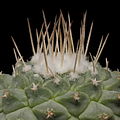| Strombocactus | |
|---|---|

| |
| Strombocactus disciformis subsp. disciformis | |
| Conservation status | |
 Vulnerable (IUCN 3.1) | |
| CITES Appendix I (CITES) | |
| Scientific classification | |
| Kingdom: | Plantae |
| Clade: | Tracheophytes |
| Clade: | Angiosperms |
| Clade: | Eudicots |
| Order: | Caryophyllales |
| Family: | Cactaceae |
| Subfamily: | Cactoideae |
| Tribe: | Cacteae |
| Genus: | Strombocactus Britton & Rose |
| Species: | S. disciformis |
| Binomial name | |
| Strombocactus disciformis (DC.) Britton & Rose | |
| Synonyms | |
|
Ariocarpus disciformis (DC.) Marshall | |
Strombocactus disciformis is a rare species of cacti and the only species of the genus Strombocactus. The plant originates from Central and Northeast Mexico.
Description
Strombocactus is a monotypic genus with a strong turnip-like root, a small, depressed, roughly spherical stem covered with spirally arranged overlapping tubercles, each with a spine-bearing areole at its tip.
Strombocactus disciformis are low-growing, gray-green succulents with a broadly round, unbranched stem and root. In their natural habitats, they grow in a disk shape, half hidden in the ground, reaching around 8 cm in diameter and 2-3 cm in height. In cultivation, they become nearly spherical. Adult tubers can reach 15 cm in diameter, larger than the above-ground parts. The plant's spiral ribs are deeply notched, creating a wart-like appearance with a ratio close to the golden ratio (13:8). Areoles are located on the blunt ends of these warts, which are curved (straighter in cultivation) and have a square base. They rarely have more than four or five short, bristly thorns, which fall off after a few years.
Flowers come from new growth at the crown, emerging from the youngest areoles. The flowers, white to cream or magenta and 2.5 to 3.5 cm long and open to about 4 cm in diameter. The 7 mm long, thin-walled brown fruits contain 0.3 mm reddish-brown seeds.
Subspecies
The species has two recognized subspecies:
| Image | Subspecies | Distribution |
|---|---|---|
 |
Strombocactus disciformis subsp. disciformis | Querétaro to Hidalgo |
 |
Strombocactus disciformis subsp. esperanzae Glass & S.Arias | Guanajuato |
Distribution
Strombocactus disciformis is found in the Mexican states of Querétaro, Hidalgo, and Guanajuato, growing on almost vertical, weathered limestone rocks at altitudes of 1000 to 1600 meters.
-
 Plant growing vertically in habitat in Pena Blanca, Queretaro
Plant growing vertically in habitat in Pena Blanca, Queretaro
-
 Plants growing on rocks in Pena Blanca, Queretaro
Plants growing on rocks in Pena Blanca, Queretaro
-
 Plant growing with Mammillaria parkinsonii
Plant growing with Mammillaria parkinsonii
Taxonomy

First described as Mammillaria disciformis by Augustin-Pyrame de Candolle in 1828, the specific epithet disciformis is derived from the Latin "discus" (disc) and "-formis" (shaped), referring to the plant's shape. Nathaniel Lord Britton and Joseph Nelson Rose reclassified it as Strombocactus in 1922.
Conservation status
Both subspecies are classified as Vulnerable on the IUCN Red List, which states that it has a limited range and "is experiencing a decline in mature individuals due to illegal overcollection". The species is listed in Appendix 1 of the Convention on International Trade in Endangered Species meaning commercial international trade is prohibited and non-commercial international trade is regulated.
References
- ^ "Appendices | CITES". cites.org. Retrieved 2022-01-14.
- Anderson, Edward F.; Eggli, Urs (2005). Das grosse Kakteen-Lexikon (in German). Stuttgart (Hohenheim): Ulmer. pp. 607–608. ISBN 3-8001-4573-1.
- Venning, Frank D. Cacti (A Golden Guide). Racine, Wisconsin: Western Publishing Company, Inc. p. 155.
- "Strombocactus disciformis (DC.) Britton & Rose". Plants of the World Online. Retrieved 2024-06-11.
- Vallicelli, Valentino (2013-08-04). "Strombocactus disciformis". LLIFLE. Retrieved 2024-06-11.
 This article incorporates text from this source, which is available under the CC BY-SA 3.0 license.
This article incorporates text from this source, which is available under the CC BY-SA 3.0 license.
- D&Amp, Um National; (France), histoire naturelle (1828). "Mémoires du Muséum d'histoire naturelle". G. Dufour. Retrieved 2024-06-11.
- Britton, Nathaniel Lord; Eaton, Mary E.; Rose, J. N.; Wood, Helen Adelaide (1919). The Cactaceae : descriptions and illustrations of plants of the cactus family. Washington: Carnegie Institution of Washington. doi:10.5962/bhl.title.46288.
External links
 Media related to Strombocactus at Wikimedia Commons
Media related to Strombocactus at Wikimedia Commons Data related to Strombocactus at Wikispecies
Data related to Strombocactus at Wikispecies
| Taxon identifiers | |
|---|---|
| Strombocactus | |
| Strombocactus disciformis |
|




